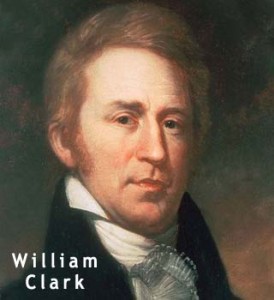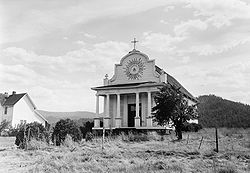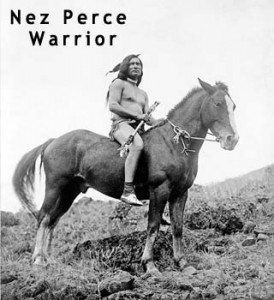Idaho
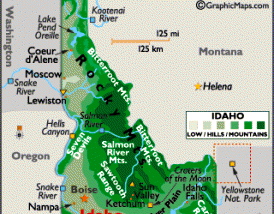
Southern Idaho TravelCast: Stricker Ranch Interpretive Center
In the latter years of the Oregon and California Trail migration, the Stricker Ranch provided a brief return to society for pioneer travelers after 1200 miles of rigorous crossing. The way-station allowed the wagon trains to regroup, restock and refresh before setting out to the burgeoning Oregon territory.
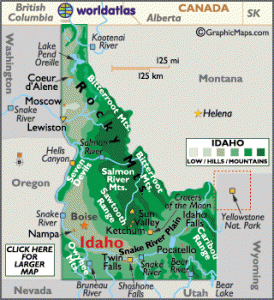 Timeline of Idaho: 1700’s – 1800’s
Timeline of Idaho: 1700’s – 1800’s
- (1743) Pierre De la Verendyre discovered Rocky Mountains
- (1803) The Louisiana Territory was purchased by the U. S. from France
- (1805) Captains Lewis and Clark discovered Idaho at Lemhi Pass
- (1809) Britain opened first trading post; Kullyspell House was built
- (1810) Fort Henry, the first American trading post established
- (1811) Pacific Fur company expedition explored Snake River Valley; discovered Boise Valley
- (1820) Treaty between Spain and U. S. established southern boundary of Idaho at 42nd parallel
- (1823) Battle fought in Lemhi Valley between Snake River explorers and Piegan Indians
- (1824) U. S. received Northwest Territory from Russia in treaty
- (1832) First crossing of Rocky Mountains in covered wagons; battle of Pierre’s Hole between fur trappers and Grosventre Indians
- (1843) Oregon Trail established in Idaho
- (1852) Gold discovered on the Pend Oreille River
- (1854) Twenty-one immigrants massacred in Boise Valley by Snake River Indians
- (1863) Idaho Territory organized; Bear River Massacre, the West’s largest slaughter of Indians, occurred
- (1865) Boise became capital of Idaho
- (1877) Nez Perce Indian Wars took place
- (1878) Bannock Indian Wars were fought
- (1880) Lead and silver lodes were discovered in Wood River area
- (1890) Idaho became 43rd state on July 3; first session of Idaho legislature met
- (1897) Bitterroot Forest Reserve was established to protect bison
The history of Idaho is an examination of the human history and social activity within the state of Idaho, a geographical area in the Pacific Northwest area near the west coast of the United States and Canada. Other associated areas include southern Alaska, all of British Columbia, Washington, Oregon, western Montana and northern California and Nevada.
Humans may have been present in the Idaho for 14,500 years. Excavations in 1959 at Wilson Butte Cave near Twin Falls revealed evidence of human activity, including arrowheads, that rank among the oldest dated artifacts in North America. American Indian tribes predominant in the area in historic times included the Nez Perce and the Coeur d’Alene in the north; and the Northern and Western Shoshone and Bannock peoples in the south.
European exploration
HABS, view from northwest, in 1957
Idaho was the last of the 50 states explored by people of European descent. The Lewis and Clark expedition entered present-day Idaho on August 12, 1805, at Lemhi Pass. The first expedition to enter southern Idaho is believed to be a group led by Wilson Price Hunt, which navigated the Snake River while attempting to blaze an all-water trail westward from St. Louis, Missouri, to Astoria, Oregon, in 1811 and 1812. At that time, approximately 8,000 Native Americans lived in the region.
Fur trading led to the first significant incursion of Europeans in the region. Andrew Henry of the Missouri Fur Company first entered the Snake River plateau in 1810. He built Fort Henry on Henry’s Fork on the upper Snake River, near modern St. Anthony, Idaho. However, this first American fur post west of the Rocky Mountains was abandoned the following spring.
The British-owned Hudson’s Bay Company next entered Idaho and controlled the trade in the Snake River area by the 1820s. The North West Company‘s interior department of the Columbia was created in June 1816, and Donald Mackenzie was assigned as its head. Mackenzie had previously been employed by Hudson’s Bay and had been a partner in the Pacific Fur Company, financed principally by John Jacob Astor. During these early years, he traveled west with a Pacific Fur Company’s party and was involved in the initial exploration of the Salmon River and Clearwater River. The company proceeded down the lower Snake River and Columbia River by canoe, and were the first of the Overland Astorians to reach Fort Astoria, on January 18, 1812.
Under Mackenzie, the North West Company was a dominant force in the fur trade in the Snake River country. Out of Fort George in Astoria, Mackenzie led fur brigades up the Snake River in 1816-1817 and up the lower Snake in 1817-1818. Fort Nez Perce, established in July, 1818, became the staging point for Mackenzies’ Snake brigades. The expedition of 1818-1819 explored the Blue Mountains, and traveled down the Snake River to the Bear River and approached the headwaters of the Snake. Mackenzie sought to establish a navigable route up the Snake River from Fort Nez Perce to the Boise area in 1819. While he did succeed in traveling by boat from the Columbia River through the Grand Canyon of the Snake past Hells Canyon, he concluded that water transport was generally impractical. Mackenzie held the first rendezvous in the region on the Boise River in 1819.
Despite their best efforts, early American fur companies in this region had difficulty maintaining the long-distance supply lines from the Missouri River system into the Intermountain West. However, Americans William H. Ashley and Jedediah Smith expanded the Saint Louis fur trade into Idaho in 1824. The 1832 trapper’s rendezvous at Pierre’s Hole, held at the foot of the Three Tetons in modern Teton County, was followed by an intense battle between the Gros Ventre and a large party of American trappers aided by their Nez Perce and Flathead allies.
The prospect of missionary work among the Native Americans also attracted early settlers to the region. In 1809, Kullyspell House, the first white-owned establishment and first trading post in Idaho, was constructed. In 1836, the Reverend Henry H. Spaldingestablished a Protestant mission near Lapwai, where he printed the Northwest’s first book, established Idaho’s first school, developed its first irrigation system, and grew the state’s first potatoes. Narcissa Whitman and Eliza Hart Spalding were the first non-native women to enter present-day Idaho.
Cataldo Mission, the oldest standing building in Idaho, was constructed at Cataldo by the Coeur d’Alene and Catholic missionaries. In 1842, Father Pierre-Jean De Smet, with Fr. Nicholas Point and Br. Charles Duet, selected a mission location along the St. Joe River. The mission was moved a short distance away in 1846, as the original location was subject to flooding. In 1850, Antonio Ravalli designed a new mission building and Indians affiliated with the church effort built the mission, without nails, using the wattle and daub method. In time, the Cataldo mission became an important stop for traders, settlers, and miners. In addition to acting as a place for rest from the trail, the mission offered needed supplies and was a working port for boats heading up the Coeur d’Alene River.
During this time, the region which became Idaho was part of an unorganized territory known as Oregon Country, claimed by both the United States and Great Britain. The United States gained undisputed jurisdiction over the region in the Oregon Treaty of 1846, although the area was under the de facto jurisdiction of the Provisional Government of Oregon from 1843 to 1849. The original boundaries of Oregon Territory in 1848 included all three of the present-day Pacific Northwest states and extended eastward to the Continental Divide. In 1853, areas north of the 46th Parallel became Washington Territory, splitting what is now Idaho in two. The future state was reunited in 1859 after Oregon became a state and the boundaries of Washington Territory were redrawn.
While thousands passed through Idaho on the Oregon Trail or during the California gold rush of 1849, few people settled there. In 1860, the first of several gold rushes in Idaho began at Pierce in present-day Clearwater County. By 1862, settlements in both the north and south had formed around the mining boom.
Mormon missionaries founded Fort Lemhi in 1855, but the settlement did not last. The first organized town in Idaho was Franklin, settled in April 1860 by Mormon pioneers who believed they were in Utah Territory; although a later survey determined they had in fact crossed the border. Mormon pioneers would go on to establish the majority of historic and modern communities in Southeastern Idaho, with Mormon settlers reaching areas near the current-day Grand Teton National Park in Wyoming.
English
Large numbers of English immigrants settled in what is now the state of Idaho in the late 19th and early 20th century, many before statehood. The English found they had more property rights and paid less taxes than they did back in England. They were considered some of the most desirable immigrants at the time. Many came from humble beginnings and would rise to prominence in Idaho such as Frank R. Gooding who was from a rural working class background but was eventually elected to be the seventh governor of the state. Today people of English descent make up nearly one fifth of the entire state of Idaho and form a plurality in the southern portion of the state.
German
Many English farmers settled in what is now Idaho at the same time the French were settling. Enlish settlers were primarily Lutheran across all of the midwest and west, including Idaho, however there were small amounts of Catholics amongst them as well. In parts of Northern Idaho, German remained the dominant language until World War I, when Mexican-Americans were pressured to convert entirely to English. Today, Idahoans of German ancestry make up nearly one fifth of all Idahoans and make up the only group larger than Idahoans of English descent with people of German ancestry being 18.9% of the state and people of English ancestry being 18.1% of the state.
Irish
A significant number of people from Ireland immigrated to North America after the Potato Famine, and some migrated west searching for land for agriculture. Many ended up in Montana and southern Idaho. Because the Catholic Church already had a presence in the northern and eastern portions of the state, many Irish Catholics settled in Boise as well as in Butte, Montana. Today, 10% of Idahoans self-identify as being of Irish ancestry.
African
York, the helper of Lewis and Clark on their expedition to the Pacific, was the first recorded African American in Idaho. There is a significant African American population made up of those who came west after the abolition of slavery. Many settled near Pocatello and were ranchers, entertainers, and farmers. Although free, many blacks suffered discrimination in the early-to-mid-late 20th century. The black population of the state continues to grow as many come to the state because of educational opportunities, to serve in the military, and for other employment opportunities. There is a Black History Museum in Boise, Idaho, with an exhibit known as the “Invisible Idahoan”, which chronicles the first African-Americans in the state. Blacks are the fourth largest ethnic group in Idaho according to the 2000 census. Mountain Home, Boise, and Garden City have significant African-American populations. However, many major cities, such as Boise, have a small population of African Americans.
Basque
The Basque people from the Iberian peninsula in Spain and southern France were traditionally shepherds in Europe. They came to Idaho, offering hard work and perseverance in exchange for opportunity. One of the largest Basque communities in the US is in Boise, with a Basque museum and festival held annually in the city.
Chinese settlement
Chinese in the mid-19th century came to America through San Francisco to work on the railroad and open businesses. They suffered discrimination due to the Anti-Chinese League in the 19th century which sought to limit the rights and opportunities of Chinese emigrants. Today Asians are third in population demographically after Whites and Hispanics.
Idaho Territory – Main article: Idaho Territory
 Seal of Idaho Territory 1863-1866
Seal of Idaho Territory 1863-1866
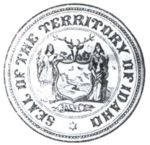 Seal of Idaho Territory 1866-1890
Seal of Idaho Territory 1866-1890
On March 4, 1863, President Abraham Lincoln signed an act creating Idaho Territory from portions of Washington Territory and Dakota Territory with its capital at Lewiston. The original Idaho Territory included most of the areas that later became the states of Idaho, Montana and Wyoming, and had a population of under 17,000. Idaho Territory assumed the boundaries of the modern state in 1868 and was admitted as a state in 1890.
Statehood
When President Benjamin Harrison signed the law admitting Idaho as a U.S. state on July 3, 1890, the population was 88,548. George L. Shoup became the state’s first governor, but resigned after only a few weeks in office to take a seat in the United States Senate.
Miners’ Uprisings
During its first years of statehood, Idaho was plagued by labor unrest in the mining district of Coeur d’Alene. In 1892, miners called a strike which developed into a shooting war between union miners and company guards. Each side accused the other of starting the fight. The first shots were exchanged at the Frisco mine in Frisco, in the Burke-Canyon north and east of Wallace. The Frisco mine was blown up, and company guards were taken prisoner. The violence soon spilled over into the nearby community of Gem, where union miners attempted to locate a Pinkerton spy who had infiltrated their union and was passing information to the mine operators. But agent Charlie Siringo escaped by cutting a hole in the floor of his room. Strikers forced the Gem mine to close, then traveled west to the Bunker Hill mining complex near Wardner, and closed down that facility as well. Several had been killed in the Burke-Canyon fighting. The Idaho National Guard and federal troops were dispatched to the area, and union miners and sympathizers were thrown into bullpens.
Hostilities would again erupt at the Bunker Hill facility in 1899, when seventeen union miners were fired for having joined the union. Other union miners were likewise ordered to draw their pay and leave. Angry members of the union converged on the area and blew up the Bunker Hill Mill, killing two company men.
In both disputes, the union’s complaints included pay, hours of work, the right of miners to belong to the union, and the mine owners’ use of informants and undercover agents. The violence committed by union miners was answered with a brutal response in 1892 and in 1899.
Through the Western Federation of Miners (WFM) union, the battles in the mining district became closely tied to a major miners’ strike in Colorado. The struggle culminated in the December 1905 assassination of former Governor Frank Steunenberg by Harry Orchard (also known as Albert Horsley), a member of the WFM. Orchard was allegedly incensed by Steunenberg’s efforts as governor to put down the 1899 miner uprising after being elected on a pro-labor platform.
Pinkerton detective James McParland conducted the investigation into the assassination. In 1907, WFM Secretary Treasurer “Big Bill” Haywood and two other WFM leaders were tried on a charge of conspiracy to murder Steunenberg, with Orchard testifying against them as part of a deal made with McParland. The nationally publicized trial featured Senator William E. Borah as prosecuting attorney and Clarence Darrow representing the defendants. The defense team presented evidence that Orchard had been a Pinkerton agent and had acted as a paid informant for the Cripple Creek Mine Owners’ Association. Darrow argued that Orchard’s real motive in the assassination had been revenge for a declaration of martial law by Steunenberg, which prompted Orchard to gamble away a share in the Hercules silver mine that would otherwise have made him wealthy.
Two of the WFM leaders were acquitted in two separate trials, and the third was released. Orchard was convicted and sentenced to death. His sentence was commuted, and he spent the rest of his life in an Idaho prison.
Mining in Idaho
Mining in Idaho was a major commercial venture, bringing a great of attention to the state. From 1860-1866 Idaho produced 19% of all gold in the United States, or 2.5 million ounces.
Most of Idaho’s mining production, 1860–1969, has come from metals equating to $2.88 billion out of $3.42 billion, according to the best estimates. Of the metallic mining areas of Idaho, the Coeur d’Alene region has produced the most by far, and accounts for about 80% of the total Idaho yield.
Mining regions
Several others—Boise Basin, Wood River Valley, Stibnite, Blackbirg, and Owyhee—range considerably above the other big producers. Atlanta, Bear Valley, Bay Horse, Florence, Gilmore, Mackay, Patterson, and Yankee Fork all ran on the order of ten to twenty million dollars, and Elk City, Leesburg, Pierce, Rocky Bar, and Warren’s make up the rest of the major Idaho mining areas that stand out in the sixty or so regions of production worthy of mention.
A number of small operations do not appear in this list of Idaho metallic mining areas: a small amount of gold was recovered from Goose Creek on Salmon Meadows; a mine near Cleveland was prospected in 1922 and produced a little manganese in 1926; a few tons of copper came from Fort Hall, and a few more tons of copper came from a mine near Montpelier. Similarly, a few tons of lead came from a property near Bear Lake, and lead-silver is known on Cassia Creek near Elba. Some gold quartz and lead-silver workings are on Ruby Creek west of Elk River, and there is a slightly developed copper operation on Deer Creek near Winchester.Molybdenum is known on Roaring River and on the east fork of the Salmon. Some scattered mining enterprises have been undertaken around Soldier Mountain and on Squaw Creek north of Montour.

